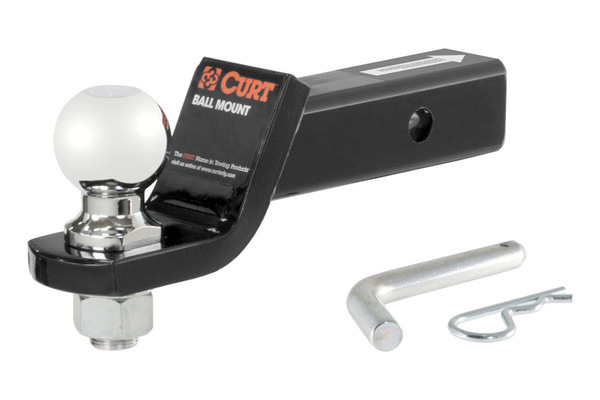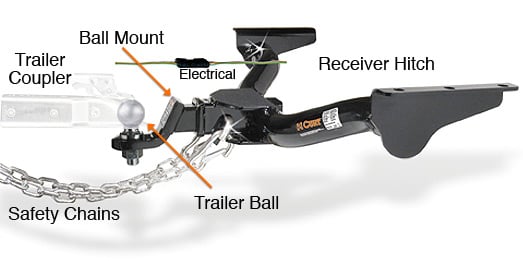How To Hook Up Your Trailer
 You've installed your trailer hitch, secured the ball mount, and hooked up all the wiring. Now you're ready to hitch up your trailer and get driving! Before you head out on your first towing adventure, make sure you follow these steps and make sure your trailer is hooked up properly. People may try to discourage you with horror stories about impossible hook-ups and reversing disasters, but the truth is with a little practice and some helpful tips you'll be hitching like a pro in no time.
You've installed your trailer hitch, secured the ball mount, and hooked up all the wiring. Now you're ready to hitch up your trailer and get driving! Before you head out on your first towing adventure, make sure you follow these steps and make sure your trailer is hooked up properly. People may try to discourage you with horror stories about impossible hook-ups and reversing disasters, but the truth is with a little practice and some helpful tips you'll be hitching like a pro in no time.
Mounting Your Trailer To The Tow Ball
Once your trailer hitch trailer ball is lined up under the coupler, it's time to drop the coupler onto the ball. Your trailer should be lifted on either its built-in jack or a floor jack. Use the jack to lower the coupler onto the tow ball. The coupler should be in its loose/open position. Make sure the coupler is in fact open, as clamps can stick if they haven't been used or maintained recently.
Safety Tip: Never use the wrong size tow ball for your trailer coupler. Even a fraction of an inch size difference between your coupler and ball can compromise your hitch connection and towing safety.A coupler can look like it's correctly mounted to the ball, but you can't count on sight alone. Many breakaway accidents are caused by drivers believing the ball is clamped when in fact it's only resting on top of the ball. When the coupler is lowered, feel the bottom of the tow ball and make sure the clamp has gripped it. The clamp release lever is also a good indicator. A properly lined-up coupler will be firm but relatively easy to clamp down. If you're facing excessive resistance from the clamp release, you're probably not completely on the ball.
Hooking Up Your Hitch - The Last Steps
At this point you've got the coupler safely clamped to the ball, so you're just about ready to go. There are a few more connections you need to make before hitting the road. These connections vary depending on what type of hitch you have, so let's take a look at the three main designs.
Connecting a Weight-Carrying Trailer Hitch
If you have a standard trailer hitch, your final connections are rather simple. They are as follows:
1. Double-check that your coupler clamp and release latch are securely hooked. Use a coupler pin or lock to keep the coupler in its closed position. Also make sure the hitch pin that holds your ball mount in the hitch receiver is safely fastened and the hitch pin is in place. Do not use a makeshift pin.
2. Connect your safety chains from the tab(s) on the hitch to the trailer. Cross them under the trailer coupler, so that in the event of a breakaway the coupler will fall onto the chains instead of directly onto the ground.
3. Plug in your trailer light wiring harness to the connector on your vehicle. Check all lights, including brake lights, turn signals, and reverse lights.
The following videos shows in more detail how to hook up your trailer to a receiver hitch:
Backing Up Your Vehicle To The Trailer
The first step towards hitching up is getting the trailer's coupler aligned with your ball mount. Unless you're hooking up a very light trailer that you can drag towards your trailer hitch, you will have to back your vehicle up to the coupler. Whether you have a friend to guide you or you're going it alone, here are some tips to help you back up safely and accurately.
Backing Up With A Spotter
Ideally, you can find someone to help you back up your trailer hitch to your trailer. Of course, that helper should be just as observant and careful as yourself. A good helper also is very clear with communication, especially sign language - if you have a loud engine, chances are you won't be able to hear your spotter. Here are some tips on backing with a helper:
1. Establish easy-to-understand sign language signals before you try backing up. Avoid using signs indicating which direction to turn the steering wheel, as that can be confusing when seen in the mirror. Instead, use signals to show where the rear of the vehicle should go, such as right/left and "towards me" or "away from me."
2. The spotter should stand on the driver's side of the trailer, near the trailer tongue. This will give the spotter the best place to view the ball/coupler line-up and to communicate with you.
3. The helper should always be clearly visible in your side view mirror.
4. Be judicious with distances when backing up. It's better to inch towards the trailer slowly in the last couple feet than to zoom backwards and drive the coupler through your license plate!
5. If you're new to this, keep your cool and don't get too frustrated. Both you and your spotter will get the hang of it with a little practice. Don't make it harder on yourself by getting angry and flustered.
Backing Up On Your Own
It can be a lot harder to back your trailer hitch up to the trailer without a helper to spot you. That doesn't mean it's impossible, however. Here are a few ways you can make backing up alone easier:Helpful Tip: Make sure you're hitching up your trailer on a flat, level surface. This will ensure you're making a proper connection and will minimize the chance of a bad accident if something goes wrong.
1. Try buying or constructing a bright stick mounted to a magnet. With the magnet clinging to the trailer coupler you can see the stick through your rear window and keep track of where the coupler is.
2. Place a piece of tape on the center of your rear window to remind you where the hitch is. If you use the tape and the stick together you can easily keep the coupler and ball mount in line.
3. You don't want the tow ball to hit the coupler as you're backing up. Make sure your trailer jack is cranked up enough so that the ball has enough clearance.
4. Get out and take a look once you're close and lined up so you can tell how much distance you have left.
5. It can be easier to gauge short distances by looking at the ground below. When making your final adjustments, keep the driver's side door open.
6. Take your time and keep your movements short, slow, and controlled. And again, don't let frustration get the best of you.
Hooking Up A Fifth Wheel Trailer
Gooseneck and 5th wheel hitches require a slightly different technique to hook up compared to a traditional ball and coupler, but many of the principles are the same.

1. Open your tailgate and raise the coupler high enough that it clears your truck bed and the hitch
2. Grease the plates on your fifth wheel hitch, or make sure the trailer ball is properly lubricated if you have a gooseneck hitch.
3. Open the jaws on your 5th wheel hitch or the clamp latch on your gooseneck trailer coupler
4. Mount the trailer. With a gooseneck, lower the coupler directly onto the ball and latch the clamp. If you have a fifth wheel trailer, back the tow vehicle up until the hitch closes over the trailer's kingpin.
5. Just like receiver hitches, attach your safety chains at the provided locations.
6. Lower and remove/stow your trailer jack, and hit the road!
Hooking Up A Weight Distributing Hitch
A weight distributing hitch requires a few extra steps to hook up due to its extra hardware and connections. Follow the same instructions as above, and do the following after you've checked your trailer lights:
1. Lift your trailer tongue up with the jack to take a bit of weight off the hitch.
2. Place the spring bars into the hitch head and guide them into position, parallel with the trailer tongue.
3. Most weight distributing hitches include a lift handle. Use this handle to move the hook-up brackets on your trailer frame down and hook up the chains at the end of the spring bars. The mechanic who installed your hitch probably told you how many chain links to count to achieve the proper tension, but if not just try to keep the tow vehicle and trailer level. Lift the hook-up brackets with the lift handle and pin the brackets into place.
4. Lower the trailer tongue jack fully and stow it away so the weight is completely settled on the towing vehicle.
5. If you're going to use a sway control device, mount it between the ball mount and your trailer frame.
Conclusion
We hope these tips will help you get safely, securely, and quickly attach your trailer to your hitch. If you have any other questions about the information in this article, feel free to call our helpful Customer Service staff at 800-663-1570.




